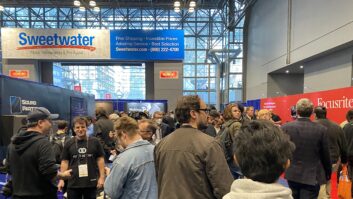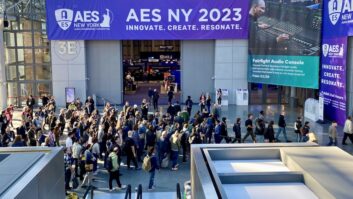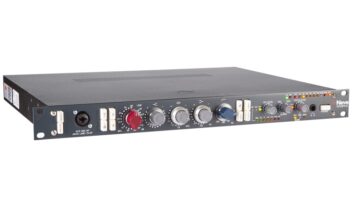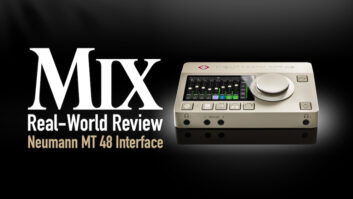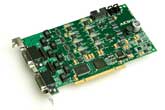
Macintosh power users rejoiced on Internet forums when the long-awaited OS X drivers for the Lynx AES16 and AES16-SRC PCI interface cards arrived in June 2004. Version 1.01 added support for changing the sample clock source from within applications (for example, Nuendo and audio and MIDI setup). It also set the maximum limit of the number of devices at high sample rate (more than 96k) to five for 10 channels of I/O.
Users of native audio applications have welcomed Lynx’s attention to the needs of engineers working in stereo and multichannel high-definition audio. For example, the Lynx AES16 was the first soundcard to offer 16 simultaneous channels of single-wire, 192kHz/24-bit digital I/O (switchable to eight channels of dual-wire digital I/O at 192 kHz). Its extraordinarily solid reclocking system, SynchroLock™, provides superior jitter reduction. I wanted to see if the Lynx quality stood up in OS X, so I took the new drivers for a spin. The focus of this test is on the AES16-XLR (MSRP: $795), LynxTWO mixer applet (included) and the optional LS-ADAT ($249).
WHEN IS CLOCKING TOO GOOD?
To check out the new OS X low-latency drivers on my Twin-Gig G4 with OS 10.3.4 and Nuendo V. 2.2, I created a 96kHz session, clocked internally, and recorded the 44.1kHz digital audio output from a CD player. The first question was, “Where’s the snatting?” A quick call to Lynx software engineer David Hoatson confirmed the only quirk with the system: The reclocking is so good that often you will only notice a snat after minutes of recording excellent audio material. Bottom line: You can’t depend on poor audio quality to inform you of a synchronization mistake. A simple solution is to purchase the AES16-SRC ($995) with sample rate conversion. The decision between these two should be based on the engineer’s need for reliability in a fast-paced environment with multiple users of equipment vs. the engineer’s perception of the audio quality with SRC applied. I did not test the AES16-SRC, so I have not been able to compare the two versions.
Both cards come with HD26-to-XLR and clock cables. The aforementioned optional daughterboard, called the LS-ADAT, has two ADAT Lightpipe I/Os with S/MUX support for 16 channels at 48 kHz and up to four channels at 192 kHz. Note: Although PC users may link several Lynx cards, Mac users running Nuendo are limited to one card. Digital Performer 4 users can use four cards per system.
MAC INSTALLATION CONCERNS
The AES16 card ships with Windows firmware installed; Mac users must update the onboard flash memory before using the card. A simple utility called L2Update_OSX.sit is provided.
Before installing the AES16 device driver and mixer, earlier versions should be removed using a third-party uninstaller. I used DesInstaller to remove my beta version of the LynxTWO_OSX.pkg. The utility is available at www.macfixit.com/library/osxu.shtml.
DREAM MULTIROOM ROUTING
To facilitate the connection of JamSync’s second-floor Nuendo room with the primary listening control room, I used the LynxTWO mixer applet. It provides digital routing via virtual patchbay with zero latency and allowed me to save and load scenes to configure the mixer for my various converters and save the settings.
I used the LS-ADAT 16-channel LStream interface to send and receive 96kHz audio with an old Nuendo 8 I/O (an OEM’d RME Hammerfall). From the AES16 cables, I routed eight channels of 48kHz AES/EBU audio I/O to an Apogee AD-8000. I assigned the same eight-output stream to the second set of AES/EBU cables using the LynxTWO mixer patchbay. Then, I routed these cables to the studio’s basement, which houses the Lighthouse K Series AES router. This audio was routed to the first-floor control room with a Prism ADA-8 converter and Snell THX 500 monitoring system.
I recorded several sets of 5.1 tracks with a Soundfield MKV mic and the MKV control unit. W, X, Y and Z were connected to the SP451 surround processor with channel degree settings as: L = -45, C = 0, R = +45, Lr = -135 and Rr = +135. LFE was derived from its own virtual omni mic.
The results were stunning at 48- and 96 kHz, and the AES16’s excellent clocking provided the only time I’ve been able to rely on the upstairs Nuendo system to provide excellent audio in the downstairs control room. (Having a Prism ADA-8 in the control room certainly contributed to the playback quality.) I did note that buffers in Nuendo needed to be set at 1,024 to prevent glitching at 96 kHz.
The rich flexibility of the LynxTWO mixer cannot be overstated. On the Adapter page, you can troubleshoot your system using parameters such as rate detection, CRC data, validity and parity.
HAPPY, HAPPY, JOY, JOY
I was impressed by the total system including the Lynx AES16, optional LS-ADAT and LynxTWO mixer. Although the mixer can be confusing at times (sometimes channels are numbered as single channels, other times as pairs), it’s a great routing and troubleshooting tool that outclasses other such applets I’ve seen by a country mile.
With Apple remote software, I can be in any of JamSync’s three studios, control Nuendo from a Mac notebook and send its output to any room using the LynxTWO mixer with the studio’s switcher. In fact, I can have one engineer in the Nuendo room adding sound effects so that the mixer in the control room can proceed with mixing and audio sweetening for video. I have been looking forward to this day, and it arrived when the Lynx OS X drivers finally appeared. They’re well worth the wait.
Lynx Studio Technology, 949/515-8265, www.lynxstudio.com.
K.K. Proffitt is co-owner of JamSync in Nashville.
